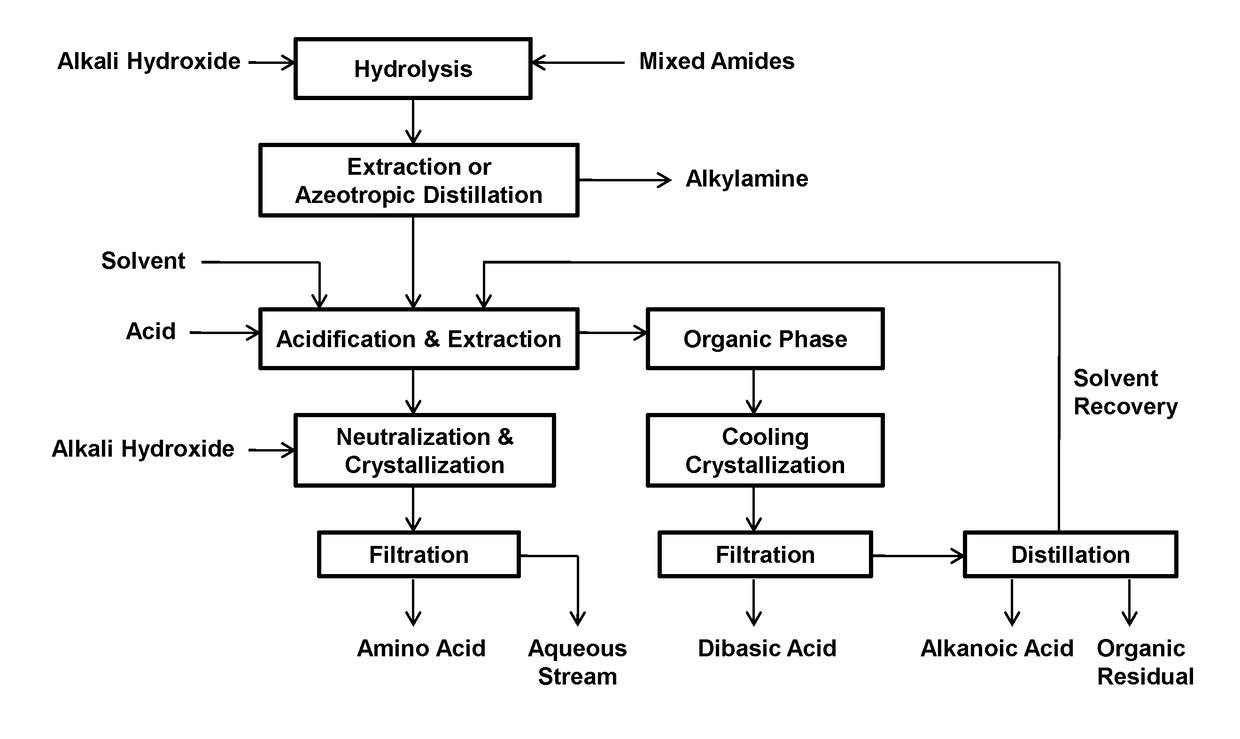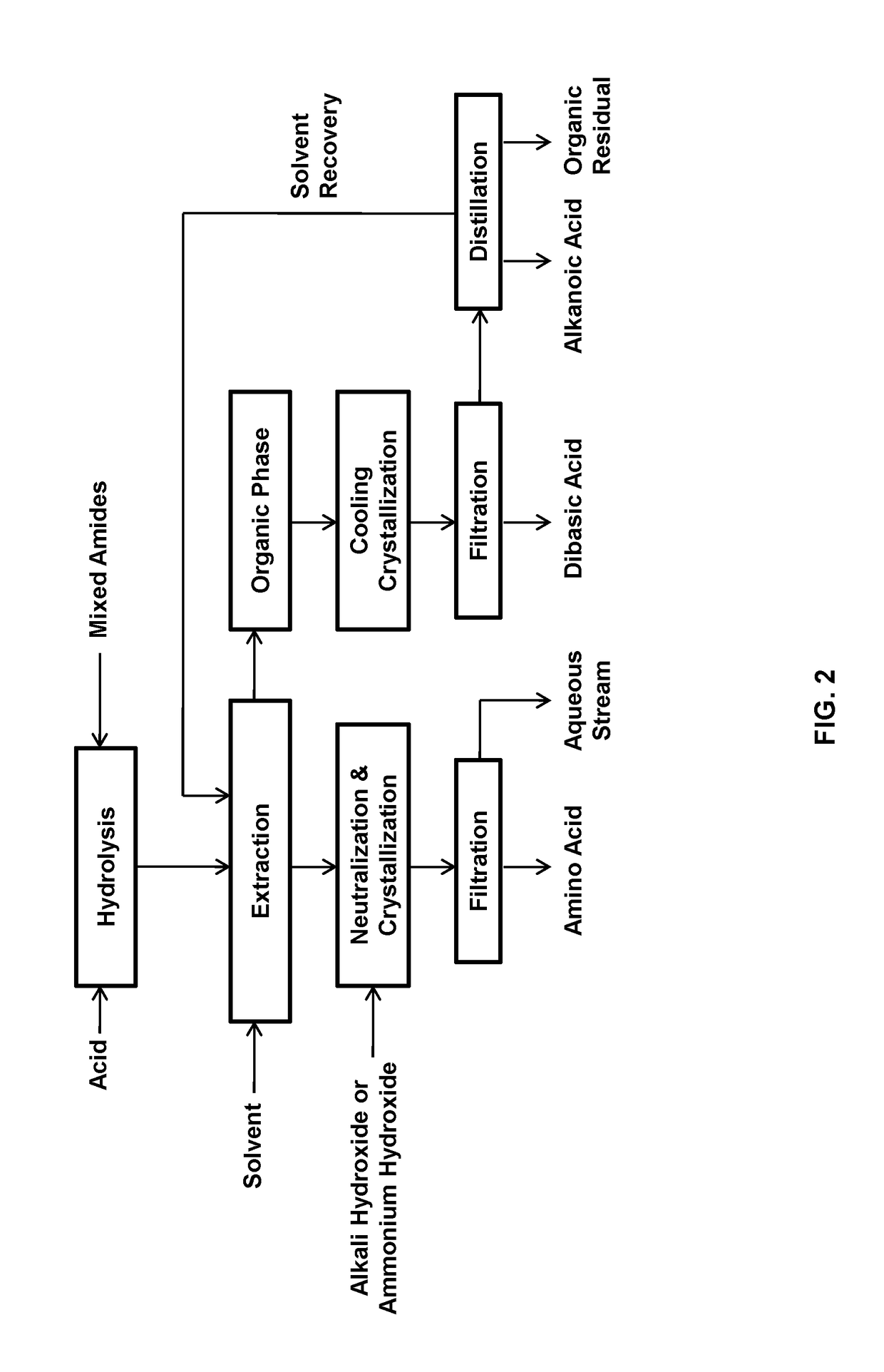Process for the separation of long chain amino acids and dibasic acids
- Summary
- Abstract
- Description
- Claims
- Application Information
AI Technical Summary
Benefits of technology
Problems solved by technology
Method used
Image
Examples
example 1
[0077]This example relates to the separation of 11-aminoundecanoic acid, dodecanedioic acid, hexylamine, heptanoic acid, and stearic acid from their mixture obtained from sodium hydroxide hydrolysis of the mixed amide derivatives.
[0078]A mixture of the starting solution was obtained by hydrolyzing 150 g of the mixed amide derivatives prepared from methyl 12-ketostearate according to WO2017 / 088218 with 60 g of sodium hydroxide in 800 mL of water.
[0079]The solution was azeotropically distilled with a 2.5×30 cm vacuum jacketed column packed with porcelain berl saddles, first to obtain methanol, then an azeotrope of hexylamine-water until the pH of the overhead became neutral at a pH of 7-8. The distillate was separated into two phases and the lower aqueous phase was continuously returned to the distillation flask. The crude hexylamine was dehydrated by azeotropic distillation to yield 20.5 g of hexylamine.
[0080]To the residual solution were added 800 mL of toluene, followed by 100 g of...
example 2
[0086]This example relates to the separation of 11-aminoundecanoic acid, dodecanedioic Acid, hexylamine, heptanoic acid, and stearic acid from their mixture of sulfuric acid hydrolysis of the mixed amide derivatives.
[0087]A mixture of the starting suspension was obtained by hydrolyzing 150 g of the mixed amide derivatives prepared from methyl 12-ketostearate according to WO2017 / 088218 with a mixture of 150 g of sulfuric acid and 30 g of water. During the hydrolysis, low-boiling methanol was continuously removed.
[0088]To the reaction suspension were added 800 g of water and 800 mL of toluene. The mixture was vigorously stirred for 60 minutes at 85° C. and transferred to a separatory funnel to separate the two phases.
[0089]The toluene phase was treated the same way as in Example 1 and similar results were obtained for each component.
[0090]The aqueous phase was neutralized with aqueous solution of sodium hydroxide to neutral pH at 7.5 for a total of 115 g of sodium hydroxide. After coo...
example 3
[0093]This example relates to the separation of 9-aminononanoic acid, sebacic acid, octylamine, and pelargonic acid.
[0094]A mixture of the starting solution was obtained by hydrolyzing 150 g of the mixed amide derivatives prepared from methyl 10-ketostearate according to WO2017 / 088218 with 60 g of sodium hydroxide in 800 mL of water.
[0095]To the turbid solution was added 200 mL of toluene and the mixture was vigorously stirred at a temperature of 80° C. for 45 minutes. Afterwards, the toluene phase was separated and removed to yield a residual, which was distilled to obtain 29.5 g of n-octylamine.
[0096]The aqueous phase was treated the same way as in Example 1 to obtain 36.9 g of pelargonic acid, 39.6 g of 9-aminononanoic acid, and 45.5 g of sebacic acid.
PUM
| Property | Measurement | Unit |
|---|---|---|
| Temperature | aaaaa | aaaaa |
| Temperature | aaaaa | aaaaa |
| Temperature | aaaaa | aaaaa |
Abstract
Description
Claims
Application Information
 Login to View More
Login to View More - R&D
- Intellectual Property
- Life Sciences
- Materials
- Tech Scout
- Unparalleled Data Quality
- Higher Quality Content
- 60% Fewer Hallucinations
Browse by: Latest US Patents, China's latest patents, Technical Efficacy Thesaurus, Application Domain, Technology Topic, Popular Technical Reports.
© 2025 PatSnap. All rights reserved.Legal|Privacy policy|Modern Slavery Act Transparency Statement|Sitemap|About US| Contact US: help@patsnap.com



